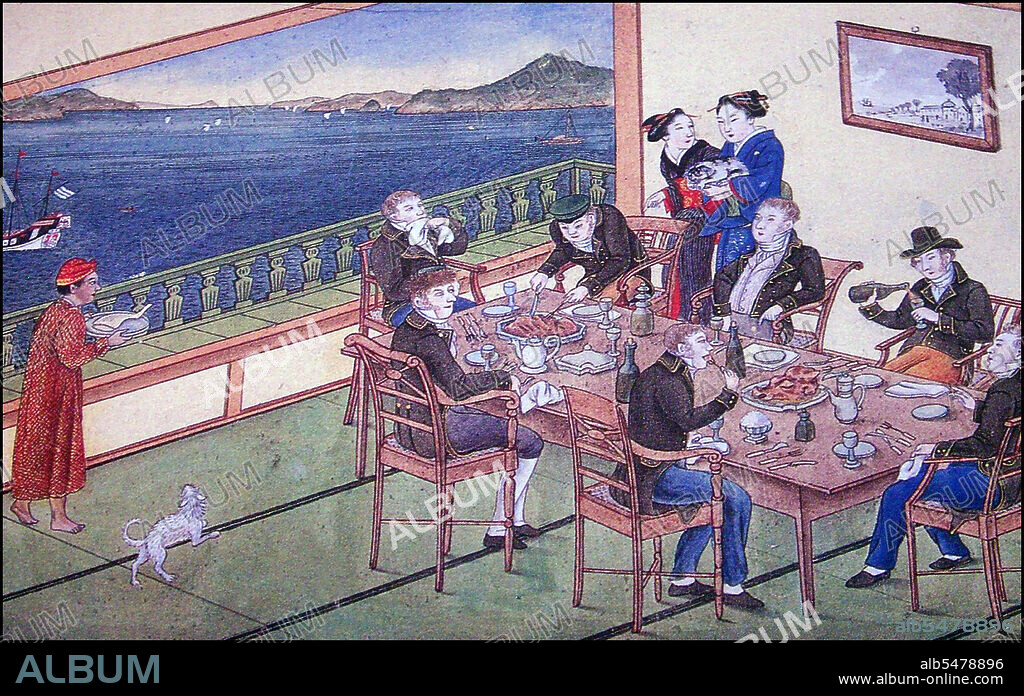alb5478896
Japan: A group of Dutch traders dining at Dejima Island, Nagasaki, c.1825. Philip Franz Von Siebold seated, centre, with his mistress, Kusomoto Taki (Sonogi) holding cat

|
Ajouter à une autre Lightbox |
|
Ajouter à une autre Lightbox |



Avez-vous déjà un compte? S'identifier
Vous n'avez pas de compte ? S'inscrire
Acheter cette image

Titre:
Japan: A group of Dutch traders dining at Dejima Island, Nagasaki, c.1825. Philip Franz Von Siebold seated, centre, with his mistress, Kusomoto Taki (Sonogi) holding cat
Légende:
Traduction automatique: Dejima (littéralement « île de sortie » ; néerlandais : Desjima ou Deshima, parfois latinisé comme Decima ou Dezima) était une petite île artificielle en forme d'éventail construite dans la baie de Nagasaki en 1634. Cette île, qui a été formée en creusant un canal à travers un petite péninsule, est resté le seul lieu de commerce direct et d'échange entre le Japon et le monde extérieur pendant la période Edo. Dejima a été construit pour contraindre les commerçants étrangers dans le cadre de la politique isolationniste auto-imposée du «sakoku». Construit à l'origine pour abriter des commerçants portugais, il est devenu un poste de traite chinois et hollandais de 1641 à 1853. Couvrant une superficie de 120 mx 75 m (9 000 mètres carrés ou 0,9 hectare), il a ensuite été intégré à la ville. « Dejima Dutch Trading Post » a été désigné site historique national japonais.
Dejima (literally 'exit island'; Dutch: Desjima or Deshima, sometimes latinised as Decima or Dezima) was a small fan-shaped artificial island built in the bay of Nagasaki in 1634. This island, which was formed by digging a canal through a small peninsula, remained as the single place of direct trade and exchange between Japan and the outside world during the Edo period. Dejima was built to constrain foreign traders as part of the 'sakoku' self-imposed isolationist policy. Originally built to house Portuguese traders, it changed to a Chinese and Dutch trading post from 1641 until 1853. Covering an area of 120 m x 75 m (9000 square meters, or 0.9 hectares) it later became integrated into the city. 'Dejima Dutch Trading Post' has been designated a Japanese national historic site.
Crédit:
Album / Pictures From History/Universal Images Group
Autorisations:
Modèle: Non - Propriété: Non
Questions sur les droits?
Questions sur les droits?
Taille de l'image:
5330 x 3348 px | 51.1 MB
Taille d'impression:
45.1 x 28.3 cm | 17.8 x 11.2 in (300 dpi)
Mots clés:
ASIE • ASIE, CONTINENT • BATEAU PORT • CHINOIS • CHINOISE • CONTINENT ASIE • DEBARCADERE • EMBARCADÈRE • EPOQUE EDO • HISOIRE • HISTOIRE • HOLLANDAIS • HOLLANDAISE • JAPON • JAPON-EDO PERIOD • JAPONAIS • JAPONAISE • METIER • NAGASAKI • ORNEMENT, JAPONAIS • PORT • PORTS • VETEMENT: HOLLANDAIS
 Pinterest
Pinterest Twitter
Twitter Facebook
Facebook Copier le lien
Copier le lien Email
Email
